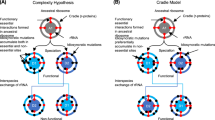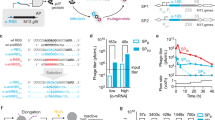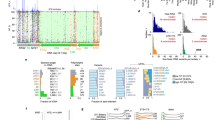Abstract
It is generally assumed that each organism has evolved to possess a unique ribosomal RNA (rRNA) species optimal for its physiological needs. However, some organisms express divergent rRNAs, the functional roles of which remain unknown. Here, we show that ribosomes containing the most variable rRNAs, encoded by the rrnI operon (herein designated as I-ribosomes), direct the preferential translation of a subset of mRNAs in Vibrio vulnificus, enabling the rapid adaptation of bacteria to temperature and nutrient shifts. In addition, genetic and functional analyses of I-ribosomes and target mRNAs suggest that both I-ribosomal subunits are required for the preferential translation of specific mRNAs, the Shine–Dalgarno sequences of which do not play a critical role in I-ribosome binding. This study identifies genome-encoded divergent rRNAs as regulators of gene expression at the ribosome level, providing an additional level of regulation of gene expression in bacteria in response to environmental changes.
This is a preview of subscription content, access via your institution
Access options
Access Nature and 54 other Nature Portfolio journals
Get Nature+, our best-value online-access subscription
$29.99 / 30 days
cancel any time
Subscribe to this journal
Receive 12 digital issues and online access to articles
$119.00 per year
only $9.92 per issue
Buy this article
- Purchase on Springer Link
- Instant access to full article PDF
Prices may be subject to local taxes which are calculated during checkout






Similar content being viewed by others
References
Noller, H. F. Evolution of protein synthesis from an RNA world. Cold Spring Harb. Perspect. Biol. 4, a003681 (2012).
Klappenbach, J. A., Saxman, P. R., Cole, J. R. & Schmidt, T. M. rrndb: the Ribosomal RNA Operon Copy Number Database. Nucleic Acids Res. 29, 181–184 (2001).
Long, E. O. & Dawid, I. B. Repeated genes in eukaryotes. Annu. Rev. Biochem. 49, 727–764 (1980).
Hashimoto, J. G., Stevenson, B. S. & Schmidt, T. M. Rates and consequences of recombination between rRNA operons. J. Bacteriol. 185, 966–972 (2003).
Boucher, Y., Douady, C. J., Sharma, A. K., Kamekura, M. & Doolittle, W. F. Intragenomic heterogeneity and intergenomic recombination among haloarchaeal rRNA genes. J. Bacteriol. 186, 3980–3990 (2004).
Carranza, S., Giribet, G., Ribera, C., Baguna & Riutort, M. Evidence that two types of 18S rDNA coexist in the genome of Dugesia (Schmidtea) mediterranea (Platyhelminthes, Turbellaria, Tricladida). Mol. Biol. Evol. 13, 824–832 (1996).
Gunderson, J. H. et al. Structurally distinct, stage-specific ribosomes occur in Plasmodium. Science 238, 933–937 (1987).
Kim, H. L. et al. Expression of divergent LSU rRNA genes in the Vibrio vulnificus CMCP6 genome during both infection and non-pathogenic stages. Curr. Microbiol. 62, 133–138 (2011).
Mashkova, T. D. et al. The primary structure of oocyte and somatic 5S rRNAs from the loach Misgurnus fossilis. Nucleic Acids Res. 9, 2141–2151 (1981).
Parks, M. M. et al. Variant ribosomal RNA alleles are conserved and exhibit tissue-specific expression. Sci. Adv. 4, eaao0665 (2018).
Wang, Y., Zhang, Z. & Ramanan, N. The actinomycete Thermobispora bispora contains two distinct types of transcriptionally active 16S rRNA genes. J. Bacteriol. 179, 3270–3276 (1997).
Yap, W. H., Zhang, Z. & Wang, Y. Distinct types of rRNA operons exist in the genome of the actinomycete Thermomonospora chromogena and evidence for horizontal transfer of an entire rRNA operon. J. Bacteriol. 181, 5201–5209 (1999).
Locati, M. D. et al. Expression of distinct maternal and somatic 5.8S, 18S, and 28S rRNA types during zebrafish development. RNA 23, 1188–1199 (2017).
Pei, A. Y. et al. Diversity of 16S rRNA genes within individual prokaryotic genomes. Appl. Environ. Microbiol. 76, 3886–3897 (2010).
Vetrovsky, T. & Baldrian, P. The variability of the 16S rRNA gene in bacterial genomes and its consequences for bacterial community analyses. PLoS ONE 8, e57923 (2013).
Waters, A. P., Syin, C. & McCutchan, T. F. Developmental regulation of stage-specific ribosome populations in Plasmodium. Nature 342, 438–440 (1989).
Velichutina, I. V., Rogers, M. J., McCutchan, T. F. & Liebman, S. W. Chimeric rRNAs containing the GTPase centers of the developmentally regulated ribosomal rRNAs of Plasmodium falciparum are functionally distinct. RNA 4, 594–602 (1998).
van Spaendonk, R. M. et al. Functional equivalence of structurally distinct ribosomes in the malaria parasite, Plasmodium berghei. J. Biol. Chem. 276, 22638–22647 (2001).
Lopez-Lopez, A., Benlloch, S., Bonfa, M., Rodriguez-Valera, F. & Mira, A. Intragenomic 16S rDNA divergence in Haloarcula marismortui is an adaptation to different temperatures. J. Mol. Evol. 65, 687–696 (2007).
Sato, Y., Fujiwara, T. & Kimura, H. Expression and function of different guanine-plus-cytosine content 16S rRNA genes in Haloarcula hispanica at different temperatures. Front. Microbiol. 8, 482 (2017).
Kurylo, C. M. et al. Endogenous rRNA sequence variation can regulate stress response gene expression and phenotype. Cell Rep. 25, 236–248 (2018).
Zhang, J. J., Zhang, Y. L., Zhu, L., Suzuki, M. & Inouye, M. Interference of mRNA function by sequence-specific endoribonuclease PemK. J. Biol. Chem. 279, 20678–20684 (2004).
Shine, J. & Dalgarno, L. The 3′-terminal sequence of Escherichia coli 16S ribosomal RNA: complementarity to nonsense triplets and ribosome binding sites. Proc. Natl Acad. Sci. USA 71, 1342–1346 (1974).
Vesper, O. et al. Selective translation of leaderless mRNAs by specialized ribosomes generated by MazF in Escherichia coli. Cell 147, 147–157 (2011).
Culviner, P. H. & Laub, M. T. Global analysis of the E. coli toxin MazF reveals widespread cleavage of mRNA and the inhibition of rRNA maturation and ribosome biogenesis. Mol. Cell 70, 868–880 (2018).
Mets, T. et al. Fragmentation of Escherichia coli mRNA by MazF and MqsR. Biochimie 156, 79–91 (2018).
Tock, M. R., Walsh, A. P., Carroll, G. & McDowall, K. J. The CafA protein required for the 5′-maturation of 16 S rRNA is a 5′-end-dependent ribonuclease that has context-dependent broad sequence specificity. J. Biol. Chem. 275, 8726–8732 (2000).
Song, W. et al. Antibiotic stress-induced modulation of the endoribonucleolytic activity of RNase III and RNase G confers resistance to aminoglycoside antibiotics in Escherichia coli. Nucleic Acids Res. 42, 4669–4681 (2014).
Byrgazov, K., Vesper, O. & Moll, I. Ribosome heterogeneity: another level of complexity in bacterial translation regulation. Curr. Opin. Microbiol. 16, 133–139 (2013).
Simsek, D. & Barna, M. An emerging role for the ribosome as a nexus for post-translational modifications. Curr. Opin. Cell Biol. 45, 92–101 (2017).
Xue, S. & Barna, M. Specialized ribosomes: a new frontier in gene regulation and organismal biology. Nat. Rev. Mol. Cell Biol. 13, 355–369 (2012).
Thomas, J. G. & Baneyx, F. Roles of the Escherichia coli small heat shock proteins IbpA and IbpB in thermal stress management: comparison with ClpA, ClpB, and HtpG in vivo. J. Bacteriol. 180, 5165–5172 (1998).
Albery, W. J. & Knowles, J. R. Free-energy profile of the reaction catalyzed by triosephosphate isomerase. Biochemistry 15, 5627–5631 (1976).
Knowles, J. R. Enzyme catalysis: not different, just better. Nature 350, 121–124 (1991).
Elmahdi, S., DaSilva, L. V. & Parveen, S. Antibiotic resistance of Vibrio parahaemolyticus and Vibrio vulnificus in various countries: a review. Food Microbiol. 57, 128–134 (2016).
Horseman, M. A. & Surani, S. A comprehensive review of Vibrio vulnificus: an important cause of severe sepsis and skin and soft-tissue infection. Int. J. Infect. Dis. 15, e157–e166 (2011).
Lee, K., Varma, S., SantaLucia, J. Jr & Cunningham, P. R. In vivo determination of RNA structure–function relationships: analysis of the 790 loop in ribosomal RNA. J. Mol. Biol. 269, 732–743 (1997).
Orelle, C. et al. Protein synthesis by ribosomes with tethered subunits. Nature 524, 119–124 (2015).
Moll, I., Hirokawa, G., Kiel, M. C., Kaji, A. & Blasi, U. Translation initiation with 70S ribosomes: an alternative pathway for leaderless mRNAs. Nucleic Acids Res. 32, 3354–3363 (2004).
Karamyshev, A. L., Karamysheva, Z. N., Yamami, T., Ito, K. & Nakamura, Y. Transient idling of posttermination ribosomes ready to reinitiate protein synthesis. Biochimie 86, 933–938 (2004).
Blomfield, I. C., Vaughn, V., Rest, R. F. & Eisenstein, B. I. Allelic exchange in Escherichia coli using the Bacillus subtilis sacB gene and a temperature-sensitive pSC101 replicon. Mol. Microbiol. 5, 1447–1457 (1991).
Higuchi, R. in PCR Technology: Principles and Applications for DNA Amplification (ed. Erlich, H.A.) Ch. 6 (Palgrave Macmillan, London, 1989).
Moazed, D., Stern, S. & Noller, H. F. Rapid chemical probing of conformation in 16 S ribosomal RNA and 30 S ribosomal subunits using primer extension. J. Mol. Biol. 187, 399–416 (1986).
Powers, T. & Noller, H. F. A functional pseudoknot in 16S ribosomal RNA. EMBO J. 10, 2203–2214 (1991).
Ingolia, N. T. Genome-wide translational profiling by ribosome footprinting. Methods Enzymol. 470, 119–142 (2010).
Li, H. & Durbin, R. Fast and accurate short read alignment with Burrows–Wheeler transform. Bioinformatics 25, 1754–1760 (2009).
Mortazavi, A., Williams, B. A., McCue, K., Schaeffer, L. & Wold, B. Mapping and quantifying mammalian transcriptomes by RNA-seq. Nat. Methods 5, 621–628 (2008).
Tarazona, S., Garcia-Alcalde, F., Dopazo, J., Ferrer, A. & Conesa, A. Differential expression in RNA-seq: a matter of depth. Genome Res. 21, 2213–2223 (2011).
Nagaraj, N. et al. System-wide perturbation analysis with nearly complete coverage of the yeast proteome by single-shot ultra HPLC runs on a bench top Orbitrap. Mol. Cell. Proteomics 11, M111.013722 (2012).
Wisniewski, J. R., Zougman, A., Nagaraj, N. & Mann, M. Universal sample preparation method for proteome analysis. Nat. Methods 6, 359–362 (2009).
Rappsilber, J., Mann, M. & Ishihama, Y. Protocol for micro-purification, enrichment, pre-fractionation and storage of peptides for proteomics using StageTips. Nat. Protoc. 2, 1896–1906 (2007).
Wisniewski, J. R., Zougman, A. & Mann, M. Combination of FASP and StageTip-based fractionation allows in-depth analysis of the hippocampal membrane proteome. J. Proteome Res. 8, 5674–5678 (2009).
Bekker-Jensen, D. B. et al. An optimized shotgun strategy for the rapid generation of comprehensive human proteomes. Cell Syst. 4, 587–599 (2017).
Cox, J. & Mann, M. MaxQuant enables high peptide identification rates, individualized p.p.b.-range mass accuracies and proteome-wide protein quantification. Nat. Biotechnol. 26, 1367–1372 (2008).
Bolstad, B. M., Irizarry, R. A., Astrand, M. & Speed, T. P. A comparison of normalization methods for high density oligonucleotide array data based on variance and bias. Bioinformatics 19, 185–193 (2003).
Tyanova, S. et al. The Perseus computational platform for comprehensive analysis of (prote)omics data. Nat. Methods 13, 731–740 (2016).
Bassler, B. L., Wright, M., Showalter, R. E. & Silverman, M. R. Intercellular signalling in Vibrio harveyi: sequence and function of genes regulating expression of luminescence. Mol. Microbiol. 9, 773–786 (1993).
Amarasinghe, A. K., Calin-Jageman, I., Harmouch, A., Sun, W. & Nicholson, A. W. Escherichia coli ribonuclease III: affinity purification of hexahistidine-tagged enzyme and assays for substrate binding and cleavage. Methods Enzymol. 342, 143–158 (2001).
Totemeyer, S., Booth, N. A., Nichols, W. W., Dunbar, B. & Booth, I. R. From famine to feast: the role of methylglyoxal production in Escherichia coli. Mol. Microbiol. 27, 553–562 (1998).
Heo, J. et al. RraAS2 requires both scaffold domains of RNase ES for high-affinity binding and inhibitory action on the ribonucleolytic activity. J. Microbiol. 54, 660–666 (2016).
Lenz, D. H. et al. The small RNA chaperone Hfq and multiple small RNAs control quorum sensing in Vibrio harveyi and Vibrio cholerae. Cell 118, 69–82 (2004).
Acknowledgements
We thank K.-H. Lee, Y. Lee and S. N. Cohen for helpful comments. This research was supported by the National Research Foundation of Korea (NRF) funded by the Ministry of Science, ICT and Future Planning (grant no. 2018R1A5A1025077 and 2017R1A2B2011008 to K.L.; grant no. 2015R1A5A1008958 to J.B. and H.-K.C.; grant no. 2017R1D1A1B03032197 to W.S.; and grant no. 2018R1D1A1B07050434 to J.-H.Y.).
Author information
Authors and Affiliations
Contributions
W.S., M.J., J.-H.Y., E.S., M.L., Y.-I.K. and R.S. performed the experiments. Y.H., H.-K.C., J.H., J.E.L., C.J.M., Y.-H.K., S.E., Y.H., J.B. and K.L. analysed and interpreted the data. W.S., M.J., J.-H.Y., E.S., M.L., J.B. and K.L. wrote and reviewed the manuscript. J.B. and K.L designed the study, developed the methodology and supervised the study. All authors discussed the results and commented on the manuscript.
Corresponding authors
Ethics declarations
Competing interests
The authors declare no competing interests.
Additional information
Publisher’s note: Springer Nature remains neutral with regard to jurisdictional claims in published maps and institutional affiliations.
Supplementary information
Supplementary Information
Supplementary Figures 1–13, Supplementary Table 1, Supplementary Tables 3–8, Supplementary Discussion, Supplementary References.
Supplementary Table 2
List of genes obtained from ribosome profiling and transcriptome data.
Rights and permissions
About this article
Cite this article
Song, W., Joo, M., Yeom, JH. et al. Divergent rRNAs as regulators of gene expression at the ribosome level. Nat Microbiol 4, 515–526 (2019). https://doi.org/10.1038/s41564-018-0341-1
Received:
Accepted:
Published:
Issue Date:
DOI: https://doi.org/10.1038/s41564-018-0341-1
This article is cited by
-
Comparative Transcriptomic Analysis of Flagellar-Associated Genes in Salmonella Typhimurium and Its rnc Mutant
Journal of Microbiology (2024)
-
Relaxed Cleavage Specificity of Hyperactive Variants of Escherichia coli RNase E on RNA I
Journal of Microbiology (2023)
-
Genomic architecture of 5S rDNA cluster and its variations within and between species
BMC Genomics (2022)
-
Genetic variation at mouse and human ribosomal DNA influences associated epigenetic states
Genome Biology (2022)
-
Complete genome sequence of biocontrol strain Paenibacillus peoriae HJ-2 and further analysis of its biocontrol mechanism
BMC Genomics (2022)



